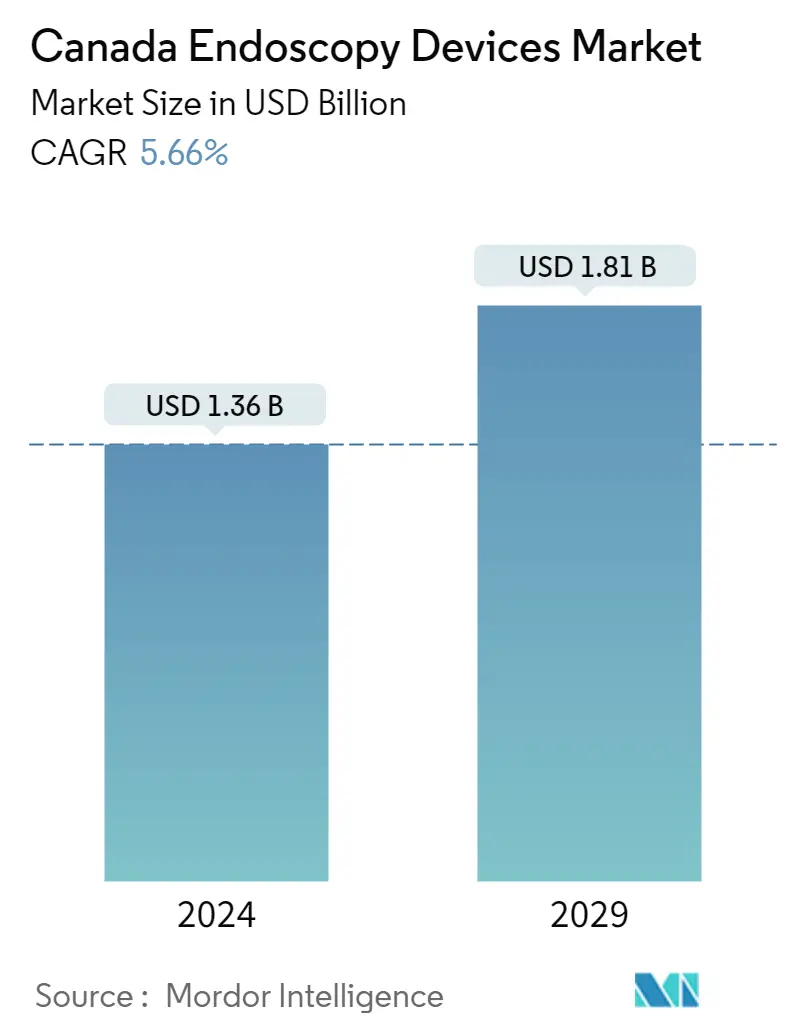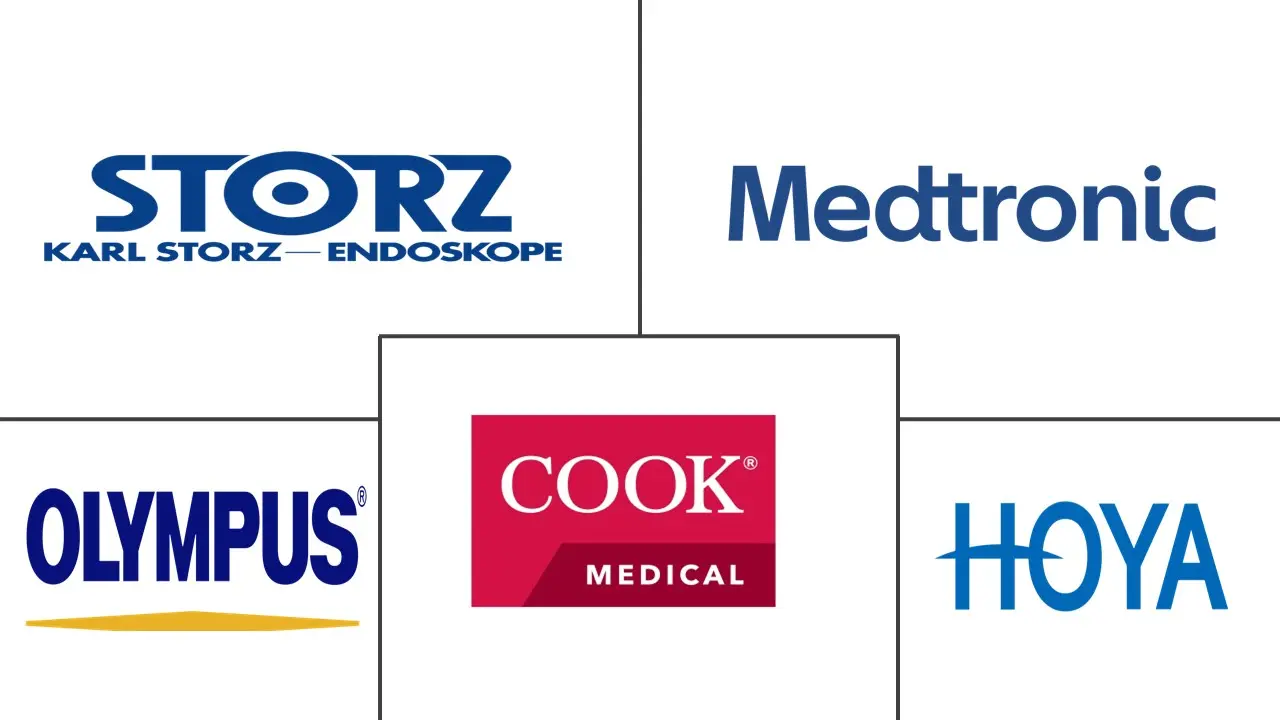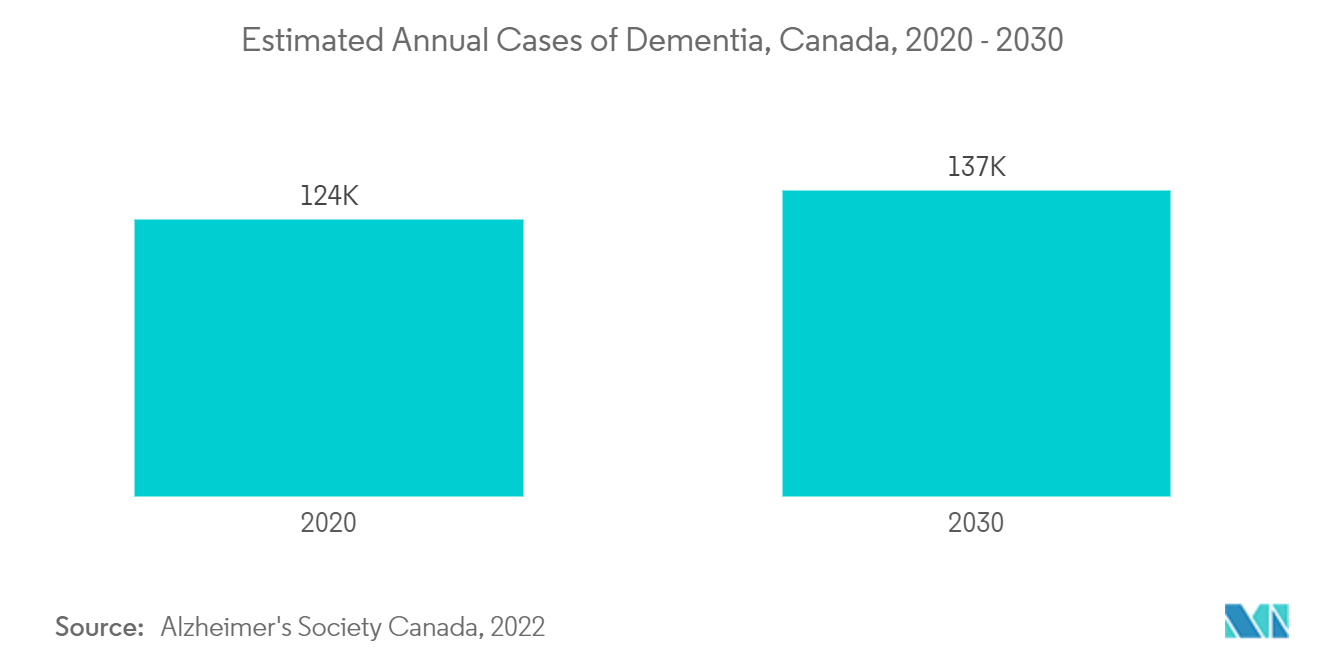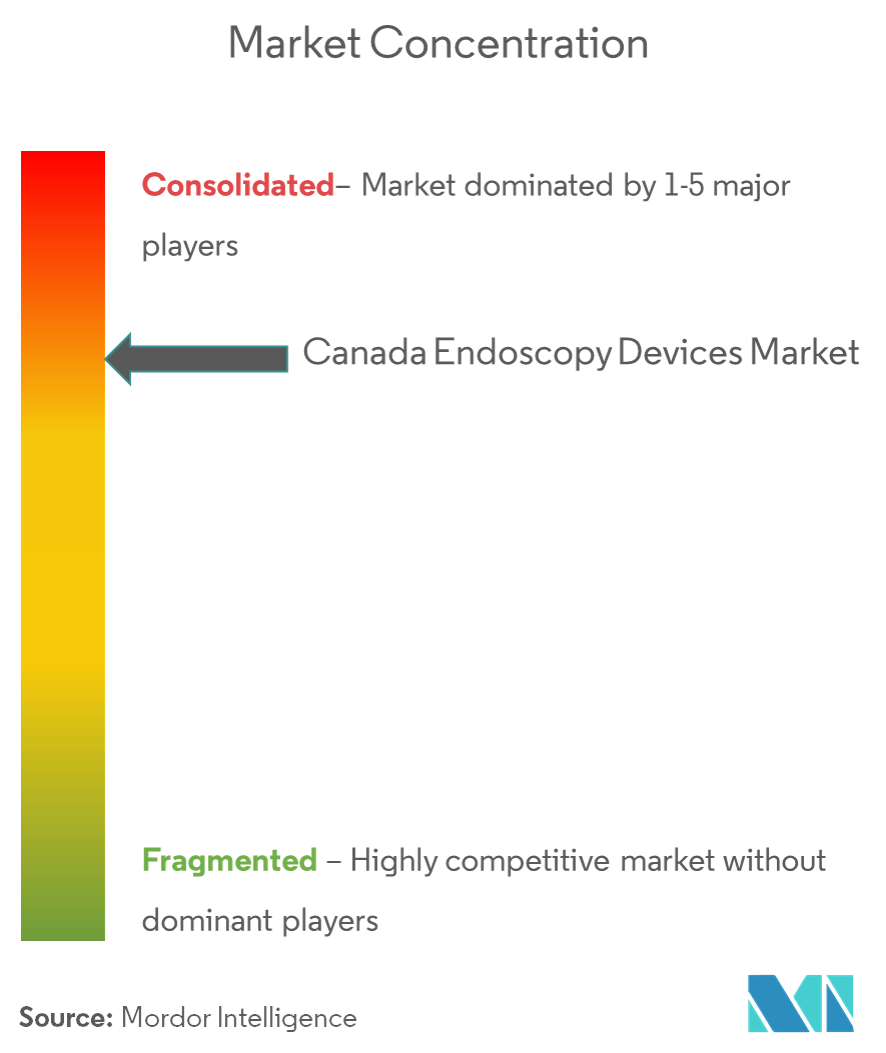Canada Endoscopy Devices Market Size

| Study Period | 2021 - 2029 |
| Base Year For Estimation | 2023 |
| Market Size (2024) | USD 1.36 Billion |
| Market Size (2029) | USD 1.81 Billion |
| CAGR (2024 - 2029) | 5.66 % |
| Market Concentration | High |
Major Players
*Disclaimer: Major Players sorted in no particular order |
Canada Endoscopy Devices Market Analysis
The Canada Endoscopy Devices Market size is estimated at USD 1.36 billion in 2024, and is expected to reach USD 1.81 billion by 2029, growing at a CAGR of 5.66% during the forecast period (2024-2029).
The COVID-19 pandemic had an impact on the growth of the market for endoscopic devices in Canada. According to the study published in the Journal of Gastroenterology and Hepatology in May 2022 stated that during the COVID-19 pandemic, there were modifications in the availability of endoscopic services. Patients hospitalized for upper gastrointestinal bleeding (UGIB) during the pandemic's initial wave were less likely to have an endoscopy. During the epidemic, endoscopic procedures revealed higher-than-expected rates of gastrointestinal bleeding and cancer. However, initiatives such as product launches are expected to increase market growth. For instance, in January 2021, PENTAX Medical increased the availability of the CapsoCam Plus video capsule system with Health Canada licensing in partnership with CapsoVision, Inc. This product expansion enables at-home administration of the CapsoCam Plus small bowel capsule endoscope during the COVID-19 pandemic for eligible patients, permitting a fully remote capsule endoscopy procedure and effectively eliminating the need for in-person interactions between clinicians and their patients. Thus, such expansions are expected to increase market growth.
Certain factors that are driving the market growth include a growing preference for minimally invasive surgeries and technological advancements. Minimally invasive surgeries (MIS) cause less post-operative pain, and hence, patients receive smaller dosages of painkillers. As there are minimal cuts or stitches involved, the hospital stay is relatively shorter, and patients need not visit the hospital frequently. Currently, people are showing interest in minimally invasive procedures rather than opting for traditional open surgeries that involve long incisions made through the muscles, and these muscles take a considerable amount of time to heal. Minimally invasive surgeries (MIS) involve smaller incisions, leading to quicker recovery. In addition, the body scars involved in minimally invasive surgeries (MIS) are barely noticeable. For instance, in June 2022, Olympus reported the first commercial treatment of Benign Prostatic Hyperplasia (BPH) in Canada utilizing the minimally invasive iTindTM method.
Additionally, the growing prevalence of chronic diseases is expected to boost the market over the forecast period. According to Globocan 2020, the incidence of stomach cancer in Canada was 3,505 in 2020, which is expected to reach 5,230 in 2040. This rising burden of cancer indicates the high requirement for endoscopic devices, which is expected to drive market study in the future.
Moreover, the rising product approval in the segment will also contribute to market growth. For instance, in April 2021, Ambu Inc. received Health Canada authorization for the aScope 4 Cysto, the company's unique flexible cystoscope platform for urology. Urologists across Canada have rapid access to a single-use cystoscope for detecting, controlling, and treating lower urinary illnesses such as hematuria, incontinence, and bladder cancer.
Thus, all aforementioned factors are expected to boost the market over the forecast period. However, infections caused by endoscopes may restrain the market growth.
Canada Endoscopy Devices Market Trends
This section covers the major market trends shaping the Canada Endoscopy Devices Market according to our research experts:
Gastroenterology is Expected to Hold a Significant Market Share Over the Forecast Period
Gastrointestinal endoscopy is a type of endoscopic technique that allows physicians to examine the digestive system by inserting a long, flexible, lighted device known as an endoscope through the rectum or down through the neck. These gastrointestinal endoscopic procedures can be used to diagnose and treat esophageal, stomach, small intestine, colon, pancreas, and bile duct problems. The increased incidence of gastrointestinal illnesses in the young, adult, and geriatric populations is one of the primary factors driving the growth of the gastroenterology segment in Canada. The rising prevalence of gastrointestinal illnesses, combined with an aging population, is boosting the demand for gastrointestinal endoscopy.
Gastrointestinal tumors are the leading cause of cancer-related deaths in Canada. Endoscopy is the gold standard for diagnosing gastrointestinal malignancies. Thus, growth in endoscopic treatments for the early detection of gastrointestinal malignancies is likely to drive the market in the future years. The majority of gastrointestinal stromal tumors begin in the rectum, colon, or esophagus. The majority of gastrointestinal stromal tumor patients are above the age of 50. The increased prevalence of malignant cancers will drive the market. According to updates from the Government of Canada in March 2021, colorectal cancer is the 3rd most common cancer in Canada. 93% of cases occur in adults aged above 50 years, and about 26,900 Canadians were diagnosed with colorectal cancer in 2020. 47% of colorectal cancer cases are diagnosed early in their development at Stages I and II. The probability of surviving colorectal cancer at least five years after diagnosis is about 65% in Canada. Screening for colorectal cancer is recommended for average-risk adults aged 50 to 74 years. Such a high burden of cancer creates the need for endoscopy devices and thus drives the growth of the segment.
Moreover, the rising product approval in the segment will also contribute to market growth. For instance, in November 2021, Medtronic Canada ULC, a part of Medtronic plc, secured a Health Canada license for the GI Genius intelligent endoscopic module. GI Genius is a computer-aided detection (CADe) system that employs artificial intelligence (AI) to identify sections of the colon suspected of having visual characteristics consistent with various forms of mucosal abnormalities.
Thus, all the above-mentioned factors are expected to boost segment growth over the forecast period.

Neurology Segment is Expected to Have Significant Growth Over the Forecast Period
Neuroendoscopy is a minimally-invasive surgical procedure under which the surgeon uses an endoscope to access the brain, spine, and peripheral nervous system. Factors such as increasing neurological disorders and minimally invasive surgeries are expected to increase market growth. For instance, in September 2022, the Alzheimer Society of Canada released a new report about dementia in Canada which stated that in 2020, it was estimated that there were 597,300 individuals living with dementia in Canada. By 030, we can expect this number will reach close to 1 million. In terms of newly-diagnosed individuals per year-what epidemiologists call annual incidence-in 2020, there were 124,000 new cases of dementia diagnosed (10,333 per month; 348 per day; 15 every hour). By 030, the annual incidence will rise to 187,000 new cases a year (15,583 per month; 512 per day; 21 every hour). Percutaneous endoscopic gastrostomy (PEG) is used as an alternative to the traditional operative procedure and rapidly became the preferred procedure. Thus, increasing neurological disorders are expected to increase segmental growth over the forecast period.
Similarly, increasing surgical treatment in the country is another factor in market growth. For instance, in March 2022, Verita Neuro started offering its services in Calgary, Canada. Wor ing in partnership with the established local neuro-rehabilitation center, Synaptic, this will be Verita Neuro's first rehabilitation support center in North America. Par of Singapore-headquartered Verita Healthcare Group, the company has been pioneering research in spinal cord injuries, traumatic brain injuries, and neurological disorders. Thu , increasing initiatives such as partnerships and increasing neurological disorders is expected to increase segmental growth over the forecast period.

Canada Endoscopy Devices Industry Overview
The Canada endoscopy device market is consolidated and consists of several major players. The various global as well as local companies are into the business. The major market share is grabbed by the global companies, whereas local companies are also throwing immense competition to gain the market share. Some of the key players in this market are Karl Storz, Medtronic PLC, Hoya Corporation, Cook Medical, and Olympus Corporation, among others.
Canada Endoscopy Devices Market Leaders
-
Karl Storz
-
Medtronic PLC
-
Hoya Corporation (Pentax Medical)
-
Cook Medical
-
Olympus Corporation
*Disclaimer: Major Players sorted in no particular order

Canada Endoscopy Devices Market News
- November 2022: PENTAX Medical launched the new Performance Endoscopic Ultrasound (EUS) system, a combination of the new ARIETTA 65 PX ultrasound scanner and their best-in-class J10 Series Ultrasound Gastroscopes in Canada.
- December 2021: Medtronic Canada ULC, a subsidiary of Medtronic plc, received a Health Canada license for the Hugo robotic-assisted surgery (RAS) system for use in urologic and gynecologic laparoscopic surgical procedures, which make up about half of all robotic procedures performed in Canada.
Canada Endoscopy Devices Market Report - Table of Contents
1. INTRODUCTION
- 1.1 Study Assumptions and Market Definition
- 1.2 Scope of the Study
2. RESEARCH METHODOLOGY
3. EXECUTIVE SUMMARY
4. MARKET DYNAMICS
- 4.1 Market Overview
-
4.2 Market Drivers
- 4.2.1 Growing Preference for Minimally Invasive Surgeries
- 4.2.2 Technological Advancements Leading to Enhanced Applications
-
4.3 Market Restraints
- 4.3.1 Infections Caused by Few Endoscopes
-
4.4 Porter Five Forces
- 4.4.1 Threat of New Entrants
- 4.4.2 Bargaining Power of Buyers/Consumers
- 4.4.3 Bargaining Power of Suppliers
- 4.4.4 Threat of Substitute Products
- 4.4.5 Intensity of Competitive Rivalry
5. MARKET SEGMENTATION (Market Size by Value - in USD Million)
-
5.1 By Type of Device
- 5.1.1 Endoscopes
- 5.1.1.1 Rigid Endoscope
- 5.1.1.2 Flexible Endoscope
- 5.1.1.3 Capsule Endoscope
- 5.1.1.4 Robot-assisted Endoscope
- 5.1.2 Endoscopic Operative Device
- 5.1.3 Visualization Equipment
-
5.2 By Application
- 5.2.1 Gastroenterology
- 5.2.2 Pulmonology
- 5.2.3 Orthopedic Surgery
- 5.2.4 Cardiology
- 5.2.5 ENT Surgery
- 5.2.6 Gynecology
- 5.2.7 Neurology
- 5.2.8 Urology
6. COMPETITIVE LANDSCAPE
-
6.1 Company Profiles
- 6.1.1 Boston Scientific Corporation
- 6.1.2 Cook Medical
- 6.1.3 Fujifilm Holdings
- 6.1.4 Instrumed Surgical
- 6.1.5 Johnson and Johnson
- 6.1.6 KARL STORZ
- 6.1.7 Medtronic PLC
- 6.1.8 Olympus Corporation
- 6.1.9 Hoya Corporation (Pantax Medical)
- 6.1.10 Stryker Corporation
- *List Not Exhaustive
7. MARKET OPPORTUNITIES AND FUTURE TRENDS
** Subject To AvailablityCanada Endoscopy Devices Industry Segmentation
As per the scope of the report, endoscopy devices are minimally invasive and can be inserted into the natural openings of the body to observe an internal organ or a tissue in detail. Endoscopic surgeries are performed for imaging procedures and minor surgeries. An endoscope is a long, thin, flexible tube with a light source and camera at one end, and the inside images are relayed to a screen. The scope considers several aspects of the market studied in terms of devices and their applications. The Canada Endoscopy Devices Market is segmented by Type of Device (Endoscopes (Rigid Endoscope, Flexible Endoscope, Capsule Endoscope, Robot-assisted Endoscopes), Endoscopic Operative Devices, and Visualization Equipment) and Application. (Gastroenterology, Pulmonology, Orthopedic Surgery, Cardiology, ENT Surgery, Gynecology, Neurology, Urology). The report offers the value (in USD million) for the above segments.
| By Type of Device | Endoscopes | Rigid Endoscope |
| Flexible Endoscope | ||
| Capsule Endoscope | ||
| Robot-assisted Endoscope | ||
| By Type of Device | Endoscopic Operative Device | |
| Visualization Equipment | ||
| By Application | Gastroenterology | |
| Pulmonology | ||
| Orthopedic Surgery | ||
| Cardiology | ||
| ENT Surgery | ||
| Gynecology | ||
| Neurology | ||
| Urology |
Canada Endoscopy Devices Market Research FAQs
How big is the Canada Endoscopy Devices Market?
The Canada Endoscopy Devices Market size is expected to reach USD 1.36 billion in 2024 and grow at a CAGR of 5.66% to reach USD 1.81 billion by 2029.
What is the current Canada Endoscopy Devices Market size?
In 2024, the Canada Endoscopy Devices Market size is expected to reach USD 1.36 billion.
Who are the key players in Canada Endoscopy Devices Market?
Karl Storz, Medtronic PLC, Hoya Corporation (Pentax Medical), Cook Medical and Olympus Corporation are the major companies operating in the Canada Endoscopy Devices Market.
What years does this Canada Endoscopy Devices Market cover, and what was the market size in 2023?
In 2023, the Canada Endoscopy Devices Market size was estimated at USD 1.29 billion. The report covers the Canada Endoscopy Devices Market historical market size for years: 2021, 2022 and 2023. The report also forecasts the Canada Endoscopy Devices Market size for years: 2024, 2025, 2026, 2027, 2028 and 2029.
Canada Endoscopy Devices Industry Report
Statistics for the 2024 Canada Endoscopy Devices market share, size and revenue growth rate, created by Mordor Intelligence™ Industry Reports. Canada Endoscopy Devices analysis includes a market forecast outlook to 2029 and historical overview. Get a sample of this industry analysis as a free report PDF download.



